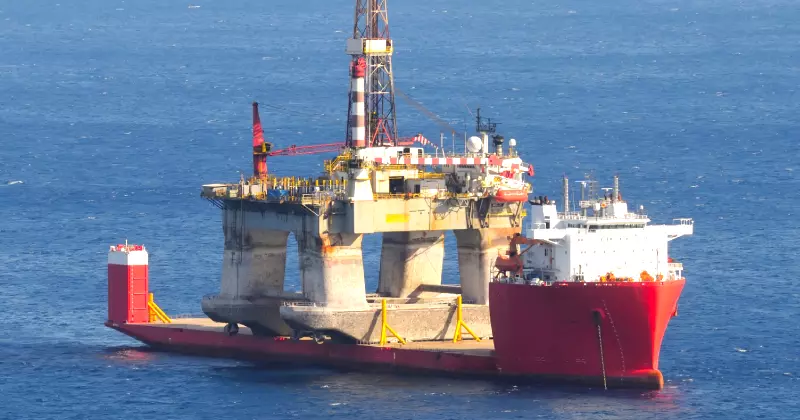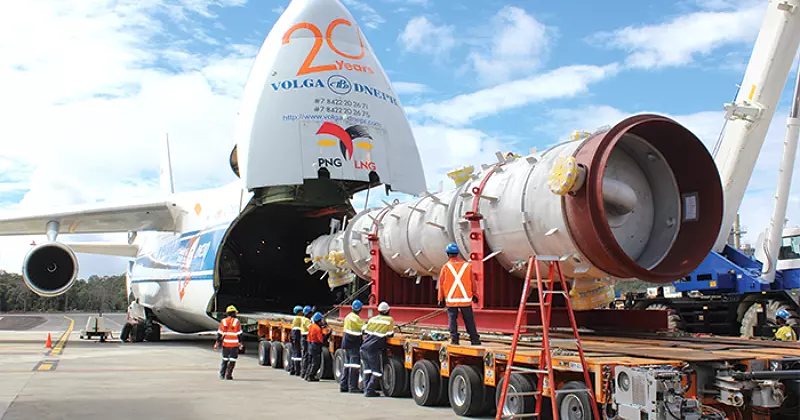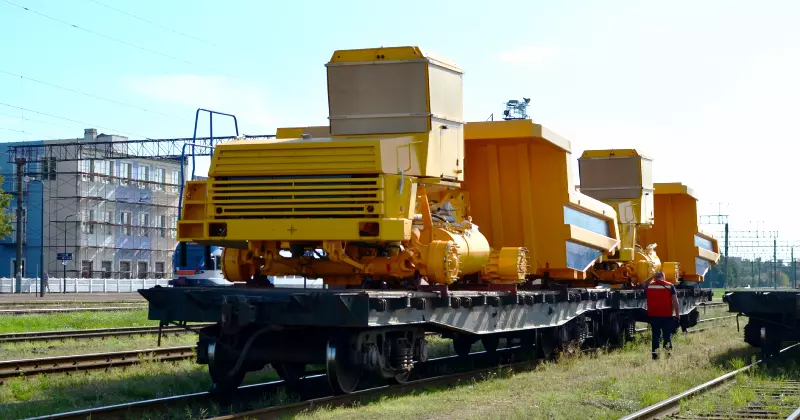Not all cargo is transported using shipping containers, unit load devices (ULDs), or straight trucks. This is because certain types of cargo don’t fit on pallets, containers, or inside conventional freight trucks, due to size or weight. This cargo is commonly referred to as project cargo or heavy lift cargo.
Content Overview:
- What Is Project Cargo
- Project Cargo Industries
- Modes of Transport
- How to Ship Project Cargo
- Useful Tips for Project Cargo
- Project Cargo News
- Service Providers
This article aims to provide you with all of the relevant information when it comes to shipping project cargo. We’ll also take a closer look at the definition of project cargo and what the most common modes of transport are. This is a comprehensive guide, so feel free to skip sections if you are already familiar with them.
What Is Project Cargo?
Project cargo is a type of cargo that is oversized, typically high value, and out of gauge cargo (OOG), requiring special equipment such as cranes, forklifts, trucks, or tools to move. This type of cargo is transported by utilizing specialized vessels, train wagons, trucks, or aircraft.
Unlike regular or general cargo that can fit on pallets, in shipping containers, or inside an aircraft ULD, where the maximum weight and dimensions are common, project cargo requires out-of-the-box creativity and technical knowledge to be transported and delivered.
As the name suggests, project cargo are usually components that are part of an overall structure or larger project. Transporting this type of cargo can be challenging, due to the nature of the cargo, its time or temperature sensitivity, weight, dimensions, and shape.
Moving project cargo also requires a proper appreciation for safety, an eye for detail, and a systematic plan that considers various logistical challenges such as road, weather, availability, and transportation conditions.
Common Project Cargo Industries
Project cargo is found in a wide variety of applications. This can include upgrades to structures, buildings, or facilities and can vary across many different industries. Let’s explore some of the more common project cargo industries below:
- Production – Any type of manufacturing or production facility will have a need for heavy machinery. These large machines, such as presses, robotics, and assembly line equipment are typically transported as project cargo.
- Energy – Project cargo transportation is also a common occurrence in the energy sector. These types of cargo include parts for power plants, wind generators, or transformers, which require special equipment.
- Aerospace – Aircraft parts like engines, wings, fuselages, or entire helicopters are often regarded as project cargo.
- Marine – Marine equipment for the assembly of large ocean vessels, which includes engines, entire sections, propellers, shafts, and various other components.
- Military – Military cargo includes the transportation of tanks, aircraft, armored vehicles, and other types of military equipment to new sites or in-between bases.
- Oil & Gas – One of the most common project cargo industries that require the transportation of oil rig parts, pipes, as well as drilling and operating equipment.
- Science – Science-related project cargo includes transportation for laboratories, such as machines, equipment, and large technical devices.
What Mode of Transport is Used for Project Cargo?
There are various ways to transport project cargo. The most common modes of transport are by air, sea, rail, and road. Most project cargo will be moved through intermodal transport, whereby the first and last leg is through road freight, and the main leg via air, sea, or rail freight. Let’s take a closer look at all of these transport modes.
Project Cargo via Sea
Shipping project cargo by sea freight is one of the most economical modes of international transport, as it’s much more affordable than air freight. However, there are also significant drawbacks, such as an increased transit time and extensive planning that is required.

Smaller project cargo that cannot be containerized is typically shipped via a flat rack or open-top containers on special vessels. Larger and more heavier parts, such as large structures, pipes, heavy engines, and machinery are sometimes transported via a chartered vessel.
As sea freight shipments may be subject to port congestion and weather conditions, meticulous planning is always required. Moreover, these types of operations are unique to the type of cargo being moved and the equipment that is required to handle it.
Project Cargo via Air
Another way to transport project cargo internationally is via air freight. While this mode of transport is typically more expensive as it requires a dedicated charter plane, it’s generally used in time-sensitive situations or if the cargo is intricate.

Project cargo that falls into this category is commonly urgent shipments that could be new machinery, replacement parts, or other larger equipment in order to prevent downtime of an existing manufacturing plant or factory.
However, there are many other scenarios where sending project cargo via air freight is feasible. Another reason is to prevent exposure of the project cargo to salt water due to long transit times at sea that may cause corrosion or damage.
In unique situations where the cargo is extremely voluminous or heavy, special charter airplanes such as the Antonov An-225 are used. Make sure to check out our list of the largest cargo planes in the world. There are various aircraft charter companies that offer these services with a wide selection of aircraft.
Project Cargo via Road
Most project cargo is moved through vast road networks using heavy lift trucks. While often used in combination when shipping project cargo internationally with air and sea freight, many local transports solely rely on road freight.

This is typically the chosen mode of transport for project cargo when moving locally, between two locations (from manufacturing to processing plants or from suppliers to facilities).
Transporting project cargo with heavy lift trucks using the road network may require local permits and additional approval due to the size and weight of the vehicle.
A road survey needs to be done to ensure the cargo clears the height of bridges or overhead obstructions. Another important aspect that needs to be checked is if the total weight is allowable during transportation.
Most roads have a maximum weight limit that may not be exceeded. As heavy lift trucks may occupy more than one lane, especially during turns, some roads may need to be temporarily closed.
Project Cargo via Rail
In certain scenarios, rail networks are also used to transport project cargo. The benefits of using rail are that it’s the most cost-effective mode of transport. Moreover, rail freight also has the ability to alleviate various external factors that could cause possible delays such as traffic, road blocks, and congestion, among many more.

Although rail freight may be selected as the main mode of transport, the pre and on-carriage is commonly done through the use of heavy lift trucks, as cargo trains usually move between rail depots and freight stations.
We welcome you to read through our general guide covering road vs rail freight, where we highlight some of the key differences between both modes of transport. We also have an article showcasing the longest cargo trains in the world.
How to Ship Project Cargo
In this section, we’ll share with you a general guide on how to ship project cargo. In these steps, you’ll learn what to take note of and what to prepare. Ensure that you familiarize yourself with this guide before planning your shipment.
1. Assess Project Cargo
Before being able to ship your project cargo, you’ll need to thoroughly assess all of the cargo and shipping details. Information that you should gather are dimensions, weight, volume, budget, preferred mode of transport and timeline.
The more information you’re able to gather, the more accurately a project cargo service provider will be able to quote you and the more prepared you are in managing your shipment.
2. Engage with Project Cargo Company
Now it’s time to select a service provider that will be able to move your cargo. We highly recommend that you engage only with reputable companies who are experienced in handling project cargo.
You’ll need to communicate your expectations, timeline, cargo information and requirements. Select your preferred company based on their deliverables and offer. We also recommended applying for cargo insurance.
3. Agree on Details & Pricing
A good project cargo company will present you with a proven methodology and a feasible handling process. They will also inform you if you require any permits or special handling equipment.
Take note that working with a company that handles the entire process is recommended, as they will also take care of the permits, equipment rental, and transport arrangements. While you are able to reduce costs working with individual service providers, you will need extensive experience.
4. Acquire all Documentation & Permits
Regulatory requirements need to be applied at the origin and destination, in order to avoid delays and extra costs such as storage or detention charges. Not having the required permits will most likely lead to fines.
If you’re unsure of what particular permits are required for your type of cargo and for which countries, feel free to reach out to your freight forwarder or project cargo company. These companies usually have a consulting team that is able to provide you with more information.
5. Ready the Cargo
Your responsibility is to ensure that your cargo is ready for transport. Your service provider should inform you beforehand what the requirements are that you need to fulfill before the cargo can be transported.
Sometimes, they will ask you to prepare or seal your cargo in a special way, depending on the mode of transport and the route or destination. Project cargo requires special handling equipment and must therefore be well protected.
6. Follow Up Closely
Work closely with your service provider and if required, also with their contractors. Also, jointly work on and monitor all the project milestones and escalate accordingly. Never hesitate to get in touch with your service provider if you have any questions throughout the entire process.
If possible, arrange for a project manager that is able to attend to all of your inquiries before, during, and after the transport arrangements. This person should also be available for any type of escalations and possess the required industry knowledge.
Useful Tips When Shipping Project Cargo
Shipping project cargo requires a good understanding of the cargo in question, as well as the respective logistics and industry knowledge. Here are some of the best practices and useful tips when shipping project cargo.
- Work with Reputable Project Cargo Companies – Be open to working with companies that offer project cargo services. We highly recommend only working with reputable service providers that have a proven track record in your industry.
- Plan Meticulously – Prepare all relent cargo and shipping information before engaging a service provider. Continue to check and recheck all scenarios and have a contingency plan available.
- Have a Team on Stand-By – Appoint a project manager to ensure there is a hands-on approach until project completion. That person should work with a counterpart from the project cargo service provider that you are engaging.
- Communicate Openly – Work closely with internal and external teams. Communicate any concerns, questions, and feedback openly and transparently. Ensure that each person knows their responsibilities and understands who to contact in case of an escalation.
- Get Multiple Quotations – Evaluate the rates of each company and study their proposals thoroughly. Having multiple proposals available to you enables you to gather more details and helps in making an informed decision.
- Have a Contingency Plan – Much work is needed during planning and even more so during the actual transport. Sometimes, things don’t go according to plan, and quick decisions and actions are needed. Therefore, have a contingency plan prepared before the project cargo transport is initiated.
- Check on Regulations – As project cargo is often heavy and voluminous, certain countries may require a special permit for the cargo or the equipment that’s handling the cargo. Check with your service provider ahead of time, in order to arrange the permits in advance.
- Keep Cargo Design in Mind – Understand that project cargo is generally transported over longer distances and may incorporate multiple modes of transport. When designing and securing your cargo, keep this in mind.
Best Place to Get Project Cargo News
The world of logistics is dynamic and innovative. This also applies for project cargo logistics across all industries. If you are in the business of transporting project cargo or are a company engaging a service provider, we highly recommend that you keep up to date with the latest news.
To get the latest news on project cargo logistics feel free to explore any of the resources below. They provide general project cargo news and updates.
Largest Project Cargo Companies & Service Providers
The following section is dedicated to showcasing some of the largest and most renowned project cargo companies and service providers globally. They have a track record of success and dedicated teams that are able to further assist you on your projects.
| Project Cargo Company | Link |
| DB Schenker | Website Link |
| Yusen | Website Link |
| GAC | Website Link |
| DHL | Website Link |
| MSC | Website Link |
| Kuehne + Nagel | Website Link |
| DSV | Website Link |
| CMA-CGM | Website Link |

Get Free Course Access
If you enjoyed the article, don’t miss out on our free supply chain courses that help you stay ahead in your industry.

Gerrit Poel
Co-Founder & Writer
at freightcourse
About the Author
Gerrit is a certified international supply chain management professional with 16 years of industry experience, having worked for one of the largest global freight forwarders.
As the co-founder of freightcourse, he’s committed to his passion for serving as a source of education and information on various supply chain topics.
Follow us